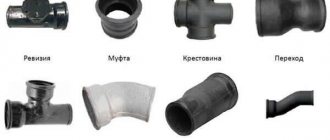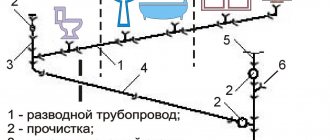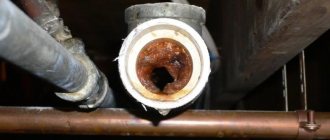The failure of the sewerage system can return all the inhabitants of the home to the Stone Age. That is why repair and replacement of the pipeline must be carried out on time, without waiting for a major leak to appear. Many apartment buildings belonging to the secondary housing market have cast iron sewer risers; most often they are in poor condition and require replacement. In this article we will try to answer questions about how the procedure for repairing and replacing a riser is carried out, what tools are needed for this, and who should carry it out in an apartment building?
When is it time to change the sewer riser?
The need to replace part of the riser arises in the following cases:
- A leak was detected.
- After purchasing a home in an apartment building (MCD), when the new owner decides to replace communications rather than wait for leaks to occur.
- Planned work.
In houses built in the middle and end of the 20th century, cast iron pipes were used in the construction of sewers. This material is reliable, but most of the objects were built a long time ago, and the communication networks have become old. Leaks often occur and repairs are required. It can be urgent, but most often the replacement is done as planned.
How to change at the expense of the Criminal Code
The procedure for free replacement of a faulty riser with the involvement of specialists from the management company is carried out in the following order:
- A plumber is called to the house, who inspects the riser, draws up a report, records all damage and confirms the validity of the replacement.
- After this, a free-form application is drawn up in 2 copies addressed to the boss, indicating the reasons for the replacement, the second copy remains in hand.
It is important that the owner does not have rent debts, otherwise the application may not be accepted for consideration, and the repair of the riser or its replacement may be denied.
- After a positive response to the application, a time is agreed upon; before starting work, plumbers visit the apartments above and warn residents about the temporary cessation of using the sewerage system.
- The tenant provides free access to the riser; most likely, he will have to remove the toilet himself or entrust this to plumbers for an additional fee; there are no other costs for replacement.
Sometimes the management company misleads residents with the statement that the riser is located in the apartment, and therefore, all costs for its repair (replacement) must be borne by the owner. With this approach, it is useful to draw the management’s attention to the document MDK 2-04.2004, according to which all sewer risers, heating radiators, water pipes in an apartment panel or brick building are common property and therefore their maintenance, repair or replacement should be carried out by the management company of the management company.
If a cast-iron sewer riser is replaced with a plastic one with the involvement of third-party specialists, the price of the work, depending on the complexity, is in the range of 5,000 - 7,000 rubles.
Rice. 5 Replacement parts
Who is obliged to change the riser
If the house is multi-apartment, part of the property of the residents is common. This applies not only to the riser, but also to the outlet from it. It is common until the first joint.
All issues related to the maintenance of property are discussed in the following documents:
- Government Decree. We are talking about document No. 491, which was released on August 8, 2006.
- Resolution of the State Committee for Construction No. 170, which considers the standards of technical operation.
- Manual released on April 2, 2004.
All work to replace common property in an apartment building must be carried out by a management company. The owner of the property or its tenant, in order to initiate their commencement, must draw up an application. It states the request, giving arguments why the riser needs to be repaired or completely replaced.
The company must consider the appeal received from the citizen and provide a response. The time when the work will be completed must be agreed upon. The property owner must be at home to provide the craftsmen with access to the premises.
The homeowner is not obliged to pay for the work of specialists and the materials used. If a representative of the management company demands payment, citing the fact that the riser is located inside the apartment, this is illegal.
At whose expense
You will only have to pay to replace the riser if the sewer system is working properly, but the property owner wants to replace the pipes. For example, the need for this may arise during the redevelopment of the premises or during a major overhaul. In all other cases there is no need to pay.
The riser belongs to the common property of the house, so repair work is carried out for money that is collected monthly for the maintenance of housing. If a social rental agreement was concluded, this means that the residential premises belong to the state. In such a situation, all funds will be taken from the municipal budget.
If the riser is replaced as planned, then the money is taken from the funds that the residents of the apartment building allocate for major repairs.
When can a tenant be denied pipe replacement?
The tenant may be denied a replacement riser.
Don’t think that the organization will immediately agree to a replacement.
She can refuse legally if the following is observed:
- The owner who submitted the application does not pay utilities. If he has debts, then replacing the riser will be postponed until they are fully repaid. The only exception is when an accident occurs.
- A work schedule has been approved, based on which repairs are planned for the house, but the property owner is going to replace the riser before the specified date.
- If the replacement was previously made by the homeowner, he bought the pipes himself.
The last point is important. If the owner of the apartment replaced the pipes, but did not coordinate this with the housing and communal services and there was no quality control, then the organization is not responsible for this section of the sewer system.
Who should carry out and pay for the replacement?
Maintenance of water supply and sewerage systems of residential buildings, as well as other engineering communications, is regulated by the Housing Legislation, Methodological Guidelines for the Maintenance and Repair of Housing Stock MDK 2-04.2004, according to which responsibilities are divided between the owner and the service organization (MC or ZhES).
According to the rules, all communications located inside the apartment are maintained or replaced by the owner himself, or with the involvement of specialists from third-party companies at his expense. If emergency situations occur inside the apartment, the owner is financially responsible for the damage caused to the neighbors below.
The vertical riser of an apartment building itself is common property, as are all the cross-shaped and tee-shaped parts in it up to the junction with the internal sewer pipeline.
Further distribution of the drain and sewer pipeline is private property and is not subject to free repairs by operational services.
Thus, when a sewer riser is leaking, the question of who should repair or replace it has a clear answer: repairing and replacing a sewer riser is the responsibility of housing and communal services workers or management companies; all work must be carried out free of charge.
Finance is obtained from contributions for major repairs or payments made for the use (maintenance) of residential premises.
If the user intends to replace a working riser with a new one for various reasons, it is clear that he must pay for the work and components carried out out of his own pocket.
Rice. 4 Example of an application
General rules for independently replacing water supply and sewerage pipes in an apartment
If you decide to do the work yourself, you need to do the following:
- Notify the company that manages residential buildings. This is done even if the property owner buys the materials himself and hires a craftsman at his own expense.
- Notify neighbors that it is planned to replace the riser.
- Turn off the water. Neighbors should be asked not to use the drain during repair work.
It is necessary to prepare the grinder in advance. It is needed to cut pipes. Connections between floors are opened using a hammer drill.
The following tools will be required:
- hacksaw;
- a piece of pipe of the required diameter and length with fittings for it;
- gas key No. 2 (2 pcs.);
- hammer;
- clamps.
To seal the cracks you will need a sealant.
When dismantling a pipe, place a bucket under it to prevent water from spilling onto the floor.
Personal or community property?
According to the rules, the responsibility for maintaining and repairing communications lies with the owners .
Water pipes that are branches from riser pipes are maintained, repaired and replaced by the owners independently and at their own expense.
Riser pipes that are used by several apartments are common property in accordance with the rules for maintaining common property in apartment buildings.
The common property also includes branches from the riser to the first connecting connection.
What is needed to replace a riser in an apartment with your own hands?
In houses built since the 50s of the 20th century, the toilet, bathroom and kitchen are located nearby. The first sewer unit is located under the sink, with a pipe coming from it. It passes through the bathroom, and in the toilet it crashes into a common riser.
Water containing waste goes into it. The pipes in the rooms are laid at a slight slope, so it moves by gravity. The pressure in the sewer system is not artificially increased. To prevent waste from stagnating in the pipes, when replacing parts of the sewer system, the degree of their slope should be controlled.
Basic mistakes when repairing a sewer system
It is possible to identify the cause of a sewer malfunction and repair it only with an understanding of how the system works. You cannot begin repairs without determining the material from which the pipeline is made. Otherwise, there is a risk of flooding your neighbors and creating an emergency that will affect the entire house. Work should be carried out in strict accordance with the technological process, observing the sequence of actions.
When choosing a material for a new sewer system, many try to save money, while the service life depends on it. You need to buy all components for repairs in trusted stores. Quality certificates must be provided for products.
Which pipes to choose
If you need to replace the old riser with a plastic one, you can use the following pipes:
- metal;
- ceramic;
- polymer.
PVC pipes for internal sewerage.
Ceramic ones are expensive. The products are not afraid of the negative effects of aggressive chemicals, which is why such pipes are often installed in enterprises. But they are not needed in apartments.
Polymer pipes are lightweight. They are good because even after several years of service, growths do not appear on their inside.
There are products made from polyvinyl chloride and polypropylene on sale. The first material is durable, it is resistant to ultraviolet radiation, but when burned and strongly heated, it releases harmful substances. Sewage drains have a low temperature, so such pipes can be used.
Polypropylene has no such disadvantages. The products are easy to install; all the work can be done on your own. Pipes have a long service life and can withstand sudden temperature changes.
Metal pipes can be steel or cast iron. The former are distinguished by their strength and resistance to high temperatures. But steel is susceptible to corrosion, so such risers are not installed in apartments.
Products made of cast iron are more expensive than others, but among their advantages can be noted their resistance to corrosion. They are durable and will last for many years.
Among the disadvantages, we can note the large weight, so it will be difficult to install the riser. Cast iron pipes become overgrown on the inside, which reduces their permeability.
How to properly dismantle the riser
If the old riser is made of cast iron, you need to act carefully when dismantling. The material is fragile, so rocking the pipe and even light impacts on it can cause cracks or chips. Defects may appear in neighbors who did not replace the pipe with a new one made of PVC.
It is best to carry out the replacement simultaneously on all floors, but not all homeowners can be persuaded. In this case, you will have to change the pipe in your apartment.
It’s good if you can replace the riser in the section between floors. If this is not done, microcracks may appear in a section of the pipe that is inaccessible to apartment owners above and below.
If a leak occurs, neighbors may accuse the repairers of doing the work carelessly. For this reason, a leak occurred and property was damaged.
General internal sewage system
The sewer system is a network of pipelines through which waste liquids are removed from premises and sent to treatment plants. There are internal and external sewerage systems. The first is located inside the building and performs the functions of collecting and removing waste from household appliances or plumbing. The second (outer) part ensures the movement of wastewater to treatment facilities. Most of the problems that occur with drainage systems occur in internal areas. This is due to the high likelihood of blockages and frequent mechanical stress. Before repairing a sewer pipe, it is necessary to study its design. Indoors, the pipeline consists of two sections:
- horizontal layout (lounger). These are plumbing outlet elements connected to a horizontal pipe; its diameter is usually 50 mm;
- riser. This is a vertical pipeline, the task of which is to drain wastewater to the external parts of the system, as well as ventilate the internal cavity of the pipelines.
The horizontal pipe is connected to a tee with a diameter of 110 mm. It is used to connect the toilet. Connection to the riser is made using another tee of the same size.
Modern pipes used to assemble drainage systems are made of plastic. Most often it is PVC. This is a cheap, fairly durable, lightweight material. Assembly and repair of plastic sewer pipes is not difficult and can be done with your own hands. The only problem when performing repair work may be dismantling the pipe line. The design of the plastic elements is such that to remove and replace a defective part, you have to disassemble the entire system from the starting point. This is inconvenient and makes work too difficult. In addition, if expensive repairs are made to the apartment, complete disassembly of the system becomes impossible. Repair of sewer pipes is required without dismantling other elements. This is a doable task, but it requires an understanding of the specifics of the system. Improper work can cause blockages.
Dismantling diagram
Dismantling begins by retreating 10 cm from the upper end of the pipe, and then making an incision. Stepping down 1 m from it, make another circular one, performing it in the form of a spiral. This is a precautionary measure so that the grinder disc will not jam. The worker will not be injured if the rebound occurs.
After this, take a hammer and chisel. The cut is tapped until the pipe bursts. If you do everything carefully, it will split along the cut line. If it is very rusty, it can be chipped off in parts.
When installing cast iron risers in old buildings, a caulking method was used or the pipe was fixed in a socket. Finding out how the pipe is held in place is easy. You need to hit it several times with a rubber sledgehammer, and then swing the riser.
An example of a sewerage diagram.
If you use carbolic acid, it will begin to fall out of the socket. If sulfur was used as fastening, blows with a sledgehammer will not budge it. In this case, you should take a blowtorch and start heating the pipe at the junction.
As a result of heating, the sulfur mass melts. The pipe is swung, held with pliers or an adjustable wrench, and then removed. The bell is cleaned of carbolic acid or traces of sulfur.
Sulfur fumes are poisonous, so you cannot work without a gas mask. After dismantling is completed, the room must be ventilated.
Part of the pipeline is the tee socket. It is required to connect the sewer pipe running from the kitchen to the toilet with a riser. It is most convenient to install tees made of plastic. To prevent leaks, all joints are coated with sealant.
When is sewer repair necessary?
Sewerage is a system of pipelines connected to plumbing and household appliances. The purpose of this design is to drain wastewater from the premises. If the system is mishandled or worn out, malfunctions occur and repairs are required.
Common problems and reasons for their occurrence
Most often, residents are faced with the problem of clogged drains. There are 2 reasons why this happens:
- When installing the pipeline, the builders violated the technology, which led to the formation of stagnant areas. In a private house, due to improper design of the system, the system freezes and an ice plug interferes with the outflow of water.
- During operation, the sewage system was used incorrectly and preventative cleaning was not carried out. Animal fat, hair, and food waste enter the system and form impenetrable plugs at the turning points of the pipes.
Another problem is the natural wear and tear of the pipeline. Constant loads lead to leaks, cracks, and the formation of fistulas, and this cannot be done without repairs.
How to assemble a new riser
The new riser is assembled from the bottom up. All sections are polished, removing burrs. This is done to prevent uneven surfaces from becoming debris collecting areas. Fasteners are installed under the sockets; clamps are used for this. The riser is fixed to the wall.
If polypropylene products are installed, use a compensator (pipe). It is put on a cut of an old pipe. At the final stage, the straight section is connected to the pipe. The pipe may not fit well into the socket; in this case, its edge is lubricated with soap.
When the installation work is completed, all joints are carefully coated with sealant.
Frequent breakdowns and how to fix them
Residents of apartments with emergency risers sometimes have to wait a very long time for action from the management company. To eliminate the annoying problem, you have to independently replace the tee in the sewer riser or change the straight section of the pipe.
Replacing the riser between floors
How to change the sewer riser if the tightness of the straight section between the floors, limited by socket joints, is broken?
The sewer coupling is destroyed. The repair will consist of replacing the section of the riser between the floors. We will need:
- a straight pipe with a length equal to the length of the section to be replaced;
- presence of a sewer compensator.
Part of the damaged cast iron sewer riser can be replaced with plastic pipes. To connect such sections, the surface of the cast iron pipe must be thoroughly cleaned of rust and layers of paint. Then put the plastic socket on the cast iron one, carefully sealing the joint.
Attention! Replacing a section of a plastic riser with cast iron pipes is impossible!
All work should be discussed with neighbors on the upper floors. We need to persuade them not to use the sewers at the prescribed times. If you have access to the basement, it is better to turn off the cold and hot water through the riser. Even in this case, among the residents there is always someone who forgets about the restrictions on the use of the sewer, so it is worth preparing a deep container in case the neighbors do use the bathroom.
The further procedure is as follows:
- Cut the sewer pipe in two places (below and above the break).
- Remove the destroyed fragment of the riser.
- Disassemble adjacent socket connections.
- Push the compensator onto the top pipe until it stops.
- Insert the straight pipe into the lower socket.
- Place the compensator in the socket.
- Secure the necks with clamps.
If the lower bell is located in the ceiling, it is not necessary to open it. You just need to add a sewer coupling. After the defective area above the ceiling is cut out, the coupling must be put on the lower pipe with the outer chamfer previously removed. Further actions are identical to those described above.
Replacing the riser in the ceiling
If the socket inside the ceiling is damaged, then dismantling the ceiling cannot be avoided. The technological hole in the concrete slab is sealed with cement-sand mortar. It needs to be broken.
First of all, it is necessary to dismantle the toilet and all fragile interior parts in the lower and upper apartments. If the lower toilet is placed on cement or glue, then you can remove only the tank and cover the bowl with a sheet of plywood or boards. The top toilet will have to be removed completely because the cross or tee needs to be replaced.
The cement-sand seal can be dismantled:
- jackhammer;
- hammer drill;
- hammer with chisel.
The further procedure looks like this:
- Make two cuts on the riser closer to the top of the area being replaced. Cast iron can be cut with a grinder or chopped with a sharp chisel; the plastic pipe is cut with an ordinary garden hacksaw;
- Dismantling the bell after bell, completely dismantle the problem area. In the upper apartment, it is often necessary to disconnect plumbing fixtures from the sewer, which makes it difficult to remove the comb from the sockets of the tee or cross;
- Assemble the riser from bottom to top. In this case, each socket must be immediately fixed to the wall with a clamp. The exception is the socket located in the ceiling: it will be securely fixed when the hole is sealed with mortar. In order for the tee or cross to coincide in height with the comb of the upper apartment, the pipe located under it will have to be cut in place;
- When assembling the riser in the upper apartment, use a compensating pipe.
Trimming plastic sockets in place is carried out in compliance with two simple rules:
- From the inside, you need to remove all burrs on which rags and other debris can cling, causing a blockage.
- A chamfer is removed from the outside, which greatly simplifies the assembly of the connection.
Attention! If the plastic socket is connected with great force, then it is worth applying a little liquid soap to the O-ring.
After assembling the riser under the ceiling, you need to assemble the formwork, for example, from plywood. Then place 2-3 reinforcement rods in the hatch, resting on the edges of the hole. Then fill the technological hole with cement-sand mortar in a ratio of 1:3.
The appearance of a leak
A typical problem with old cast iron risers is the destruction of the socket, crushed by the weight of the pipe resting on it. This problem can be solved in two ways:
- Replacing a section of the riser with a socket. The procedure is identical to that described above for replacing the riser between floors.
- Installation of a rubber bandage. It can be played by a rubber bandage purchased at a pharmacy or a bicycle inner tube cut to length.
The bandage is placed like this:
- Wrap the rubber tightly around the problem area, extending 10-15 cm onto the undamaged area.
- Tighten the bandage with tying wire.
Often the cause of sewerage leaks in the ceiling is the subsidence of the lower cast-iron pipe under the influence of its own weight. As a result of subsidence, the upper pipe completely or partially leaves the socket of the lower one, and when the riser is filled with drainage from the ceiling, it begins to flow.
Diagnosing drawdown is quite simple. A sure sign of it is an unpainted strip of cast iron on the sewer riser just below the ceiling. The reason for the subsidence is poor-quality sealing of the technological hole in the ceiling, coupled with unreliable fastening of the pipe to the wall.
The problem is solved like this:
- Place a clamp made of strong rope or thick wire on the pipe.
- Build a strong support from timber, boards or other available material on the bathroom floor;
- Then apply the lever principle: rest the crowbar or pipe on a support and place it under the clamp. The weight of an adult is usually sufficient to lift the pipe to its original position;
- Then attach the riser with clamps to the main wall. For temporary fixation, a pair of wooden wedges driven into the lower socket can be used;
- The socket is re-embossed with a heel or gland and sealed with cement mortar.
Clogged sewer pipe
If the water level in the bathtub and toilet rises even when the taps are closed, this is a sure sign of a clogged sewer riser or drain.
To clean the riser the following can be used:
- If the distance from the nearest revision to the blockage is small (up to 2-3 meters), use a sewer cable.
- At a greater distance - sewer wire.
Your task is to gain access to the nearest revision or tee located above the blockage.
Attention! Cleaning the riser from bottom to top is a very bad idea. When cleaning, a column of sewage several meters high will cover you and everything around with an even layer of a substance with an unforgettable aroma.
It is better to clean the riser together. One person pulls the cable or wire, preventing it from folding into loops, and rotates the handle; the second delivers the tool to the blockage. After the water has drained, continue to rotate the cable on the way back: this way you will not allow the cause of the blockage caught by the hook to float freely again.
If the cable or wire does not pass the blockage, you can try to clear the riser from the roof. For this purpose, a crowbar tied to a strong rope is lowered into the fan pipe. The length of the rope should not allow the crowbar to rest against the connection of the riser with the ladder: in my memory, there were cases when the crowbar pierced the cast iron bend right through.











